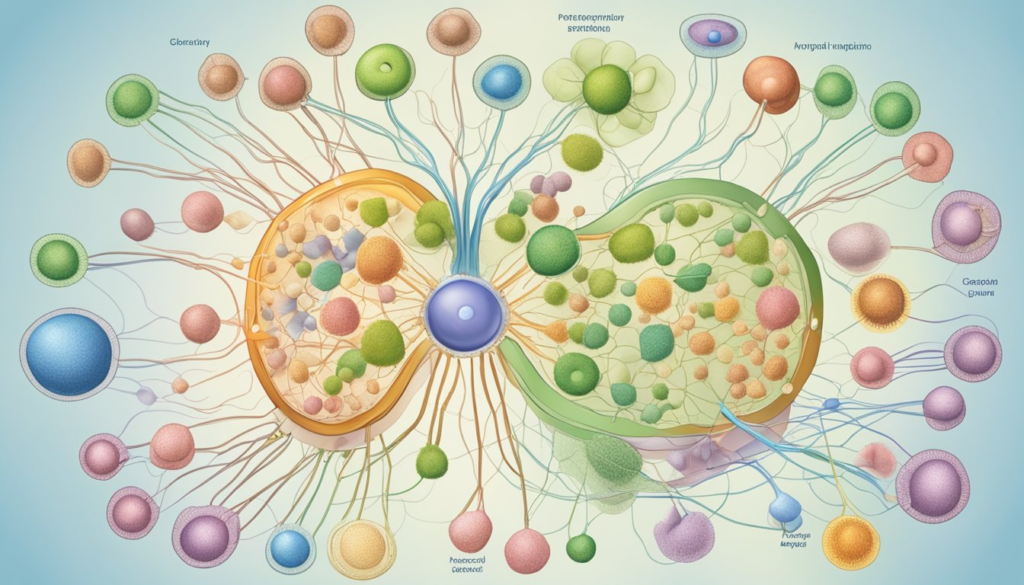The endocrine system is a complex network of glands and organs that produce, store, and secrete hormones. These chemical messengers play a crucial role in regulating a wide range of physiological processes, including growth, metabolism, reproduction, mood, and immune function. By releasing hormones into the bloodstream, the endocrine system helps maintain homeostasis—a stable internal environment necessary for optimal functioning. This article explores the primary glands of the endocrine system, the hormones they produce, and their roles in regulating body functions.
Overview of the Endocrine System
The endocrine system consists of several major glands, each responsible for producing specific hormones that regulate various bodily functions. Unlike the nervous system, which uses electrical signals for fast communication, the endocrine system relies on chemical signals that often act over a longer duration. These hormones bind to specific receptors on target cells, triggering responses that regulate vital processes.
Major Glands and Their Functions
1. Hypothalamus
Location: The hypothalamus is located in the brain, below the thalamus and above the pituitary gland.
Functions: The hypothalamus is a critical link between the nervous and endocrine systems. It regulates many bodily functions, including temperature, hunger, thirst, and sleep. It also controls the pituitary gland by releasing hormones that stimulate or inhibit pituitary hormone secretion.
Key Hormones:
- Thyrotropin-releasing hormone (TRH)
- Corticotropin-releasing hormone (CRH)
- Gonadotropin-releasing hormone (GnRH)
- Growth hormone-releasing hormone (GHRH)
2. Pituitary Gland
Location: The pituitary gland is a small, pea-sized gland located at the base of the brain, beneath the hypothalamus.
Functions: Known as the “master gland,” the pituitary gland regulates various physiological processes by releasing hormones that control other endocrine glands.
Key Hormones:
- Anterior Pituitary:
- Growth hormone (GH)
- Adrenocorticotropic hormone (ACTH)
- Thyroid-stimulating hormone (TSH)
- Luteinizing hormone (LH)
- Follicle-stimulating hormone (FSH)
- Prolactin
- Posterior Pituitary:
- Oxytocin
- Vasopressin (Antidiuretic hormone, ADH)
3. Thyroid Gland
Location: The thyroid gland is a butterfly-shaped gland located in the neck, just below the Adam’s apple.
Functions: The thyroid gland regulates metabolism, energy production, and calcium balance.
Key Hormones:
- Thyroxine (T4)
- Triiodothyronine (T3)
- Calcitonin
4. Parathyroid Glands
Location: The parathyroid glands are four small glands located on the posterior surface of the thyroid gland.
Functions: These glands regulate calcium and phosphate levels in the blood and bones.
Key Hormones:
- Parathyroid hormone (PTH)
5. Adrenal Glands
Location: The adrenal glands are triangular-shaped glands located on top of each kidney.
Functions: The adrenal glands produce hormones involved in the stress response, metabolism, immune function, and electrolyte balance.
Key Hormones:
- Adrenal Cortex:
- Cortisol (Glucocorticoids)
- Aldosterone (Mineralocorticoids)
- Androgens
- Adrenal Medulla:
- Epinephrine (Adrenaline)
- Norepinephrine (Noradrenaline)
6. Pancreas
Location: The pancreas is an elongated organ located behind the stomach.
Functions: The pancreas has both endocrine and exocrine functions. Its endocrine function involves regulating blood sugar levels.
Key Hormones:
- Insulin
- Glucagon
- Somatostatin
7. Pineal Gland
Location: The pineal gland is a small, pinecone-shaped gland located in the brain.
Functions: The pineal gland regulates sleep-wake cycles and seasonal biological rhythms.
Key Hormones:
- Melatonin
8. Gonads (Ovaries and Testes)
Location: The ovaries are located in the pelvic cavity of females, while the testes are located in the scrotum of males.
Functions: The gonads produce sex hormones responsible for the development of secondary sexual characteristics, reproduction, and sexual behavior.
Key Hormones:
- Ovaries:
- Estrogens
- Progesterone
- Testes:
- Testosterone
Hormones and Their Functions
Hormones are chemical messengers that regulate various bodily functions. Here are some key hormones and their primary roles:
1. Growth Hormone (GH)
- Produced by: Anterior pituitary
- Function: Stimulates growth, cell reproduction, and cell regeneration. It plays a role in increasing muscle mass and bone density.
2. Thyroxine (T4) and Triiodothyronine (T3)
- Produced by: Thyroid gland
- Function: Regulate metabolism, energy production, and growth. They also influence heart rate, digestion, and mental development.
3. Cortisol
- Produced by: Adrenal cortex
- Function: Regulates metabolism, immune response, and stress response. It helps the body manage stress by increasing blood sugar levels and suppressing inflammation.
4. Insulin
- Produced by: Pancreas
- Function: Lowers blood glucose levels by facilitating the uptake of glucose into cells. It also promotes the storage of glucose as glycogen in the liver.
5. Glucagon
- Produced by: Pancreas
- Function: Raises blood glucose levels by promoting the breakdown of glycogen into glucose in the liver.
6. Estrogens and Progesterone
- Produced by: Ovaries
- Function: Regulate the menstrual cycle, maintain pregnancy, and develop female secondary sexual characteristics.
7. Testosterone
- Produced by: Testes
- Function: Regulates the development of male secondary sexual characteristics, sperm production, and libido.
8. Oxytocin
- Produced by: Posterior pituitary
- Function: Stimulates uterine contractions during childbirth and milk ejection during breastfeeding. It is also involved in social bonding and emotional responses.
9. Melatonin
- Produced by: Pineal gland
- Function: Regulates sleep-wake cycles and seasonal biological rhythms.
Role of the Endocrine System in Homeostasis
The endocrine system plays a crucial role in maintaining homeostasis by regulating various physiological processes. Homeostasis refers to the body’s ability to maintain a stable internal environment despite external changes. The endocrine system helps achieve homeostasis through the following mechanisms:
1. Regulation of Metabolism
Thyroid hormones, insulin, and glucagon work together to regulate the body’s metabolism, ensuring a balance between energy production and consumption.
2. Stress Response
The adrenal glands secrete cortisol and adrenaline in response to stress, helping the body cope with physical and emotional challenges. These hormones increase blood sugar levels, heart rate, and blood pressure, preparing the body for a “fight or flight” response.
3. Electrolyte Balance
Hormones like aldosterone regulate the balance of electrolytes, such as sodium and potassium, in the body. This regulation is essential for maintaining blood pressure, fluid balance, and nerve and muscle function.
4. Reproductive Functions
Sex hormones regulate reproductive processes, including the menstrual cycle, pregnancy, and sperm production. They also influence sexual behavior and secondary sexual characteristics.
5. Growth and Development
Growth hormone, along with thyroid hormones and sex hormones, regulates growth and development from childhood to adulthood. These hormones influence bone growth, muscle mass, and overall physical maturation.
Conclusion
The endocrine system is a vital and intricate network of glands and hormones that regulate numerous bodily functions. By secreting hormones into the bloodstream, the endocrine system controls processes such as metabolism, growth, reproduction, stress response, and homeostasis. Understanding the structure and function of the endocrine system is essential for comprehending how the body maintains balance and responds to internal and external stimuli. Maintaining hormonal balance is crucial for overall health and well-being, highlighting the importance of this complex system.
FAQs
What is the primary function of the endocrine system?
The primary function of the endocrine system is to regulate various physiological processes through the secretion of hormones. These hormones control functions such as metabolism, growth, reproduction, stress response, and homeostasis.
How do hormones work in the body?
Hormones are chemical messengers produced by endocrine glands. They are released into the bloodstream and travel to target organs or tissues, where they bind to specific receptors and trigger specific biological responses.
What is the role of the hypothalamus in the endocrine system?
The hypothalamus is a crucial regulatory center in the brain that controls the release of hormones from the pituitary gland. It produces releasing and inhibiting hormones that regulate various endocrine functions, such as temperature, hunger, and circadian rhythms.
How does the pancreas regulate blood sugar levels?
The pancreas regulates blood sugar levels by producing insulin and glucagon. Insulin lowers blood glucose levels by promoting the uptake of glucose into cells, while glucagon raises blood glucose levels by stimulating the release of glucose from the liver.
What is the function of the adrenal glands?
The adrenal glands produce hormones that regulate metabolism, immune function, blood pressure, and the body’s response to stress. Key hormones include cortisol, adrenaline, aldosterone, and androgens.
How do sex hormones influence the body?
Sex hormones, such as estrogens, progesterone, and testosterone, regulate reproductive functions, including the menstrual cycle, pregnancy, and sperm production. They also influence the development of secondary sexual characteristics and sexual behavior.



